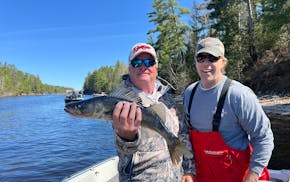The Department of Natural Resources will finalize in coming weeks a new action plan to deter invasive carp from further infesting the Mississippi, Minnesota and St. Croix rivers, as well as other Minnesota waters.
Or, considering that the last time the DNR devised an invasive carp "action" plan was in 2014, and nothing much in the intervening years has occurred to deter these fish from swimming upstream from Iowa and other points south, maybe nothing will happen.
Either way, to paraphrase the Terminator, "They're back."
Meaning oversized silver, grass and bighead carp.
And lots of them.
Last week, 323 of these finned interlopers were rounded up in Pool 6 of the Mississippi River, thanks to DNR field staff working in conjunction with contract commercial fishermen and the Wisconsin DNR.
The catch was the largest to date in Minnesota and follows reports by shore anglers and others last June of hordes of silver carp frolicking in midair beneath Lock and Dam 5, which is about halfway between Winona and Lake City, Minn.
Notably, and not a little ironically, about the same time the invaders were captured, a select group of carp experts and other stakeholders from Minnesota, Iowa, Illinois and Wisconsin ended a months-long confab about the threat these fish pose to the Upper Mississippi River region.
The group developed various good recommendations to deter the invasives, the best of which, from Minnesota's perspective, is to install a deterrent system at Lock and Dam 5 near Whitman, Minn., to minimize the number of invasive carp that can swim upstream from that juncture.
But during the coming legislative session, whether the DNR, the Legislature and Gov. Tim Walz — at the urging of various conservation groups, including Friends of the Mississippi River and MN-FISH — can find common ground and the estimated $10 million to $15 million needed to get a deterrent installed is another question.
In the last legislative session, this troika, through action and inaction, punted on the Lock and Dam 5 deterrent idea, thus raising the threat level still higher to native Minnesota fish and other aquatic life. Threatened as well are Minnesotans' summertime pastimes, including swimming, fishing, boating and water skiing.
In coming weeks, DNR leadership will receive a report from the agency's Ecological and Water Resources Division detailing recommendations from the "strategic decision-making" group that met this year to review possible invasive carp initiatives.
Among its recommendations, the group said an invasive carp deterrent system should be placed at Lock and Dam 19 near Keokuk, Iowa. That lock and dam is conducive to a deterrent installation, the group noted, and Iowa, Illinois and Wisconsin, in addition to Minnesota, would benefit from its placement.
A temporary deterrent already is in place at Keokuk, and its results are encouraging, according to the U.S. Geological Survey. But no plans have been made, and no money targeted, much less allotted, to install a permanent deterrent at Keokuk — an idea that has been considered for some 20 years.
Important to Minnesota is that the strategic decision-making group didn't only recommend a Keokuk deterrent. Considered positively as well was installation of a deterrent at Lock and Dam 5, which Minnesota advocates, including the University of Minnesota's Peter Sorensen, have long considered a critical chokepoint to safeguard state waters.
Whitney Clark, executive director of Friends of the Mississippi, hopes the DNR leverages the group's report and recommends strongly to the Legislature, and to the governor's office, that money should be appropriated this session for a deterrent at Lock and Dam 5.
Clark added that a deterrent at Keokuk is a good idea also, and when Wisconsin, Illinois, Iowa and (perhaps particularly) the feds pony up some money for its installation, Minnesota should consider contributing, too.
Boosting chances of a deterrent at Lock and Dam 5 being proposed this legislative session is the availability of bonding money. Also, key legislators toured Lock and Dam 5 recently and appeared to support the idea, which isn't particularly partisan. Republican and DFL legislators alike support taking action.
Which brings us to Walz. One word from him before the Legislature gathers in mid-February and DNR leadership will fall in line, as will DFL legislative kingpins. Staying silent on a carp deterrent at Lock and Dam 5, meanwhile, would be Walz's way of saying, "No."
In its last session, the Legislature gave the DNR $1.72 million to study dam-operation modifications to prevent upstream carp movement, explore the feasibility of a Lock and Dam 5 deterrent, add staff and equipment to increase carp tagging and commercial fishing efforts, and study ways native fish could pass through deterrents that simultaneously stop invasive carp.
Supporters of a Lock and Dam 5 deterrent had hoped that some of the money already would have been spent developing a 50% design and engineering study of the project. The DNR instead chose to postpone significant expenditures from the allotment until the strategic decision-making group offered its recommendations.
Perhaps that was the correct sequence. But it produced this problem:
Absent a Lock and Dam 5 design and engineering study, the Legislature and the governor will have to get to "Yes" without knowing the exact cost of the project — only the $10 million to $15 million estimate.
Which is unfortunate.
But the fact remains, again paraphrasing the Terminator, "They're coming."
Stay tuned.

Anderson: In early June, Minnesota fish are begging to be caught. Won't you help?

Anderson: Tails wagging, DNR officers' dogs find lost people and missing evidence
Anderson: Punish poachers more
Anderson: The Chainsaw Sisters Saloon is gone, but the Echo Trail is still a pathway to possibilities


